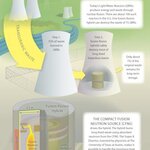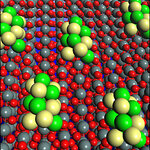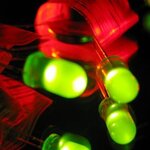Energy

Yours truly has been watching telly again! (I hope no-one will get the idea that the couch potato might be a significant source of starch.)
This time, on our local BBC news service, we hear how researchers at the University of Portsmouth Institute of Biomedical and Biomolecular Science are cooperating with their Institute of Marine Sciences to harness the Gribble.
And what can a Gribble do? As Max Bygraves sang:
Gilly Oh golly, oh I love my lolly,Come winter and summer and spring.But when you are done it’s about as much fun,As a yo-yo without any string.
Not any more…

Toxic nuclear waste is stored at sites around the U.S. and debate surrounds the construction of a large-scale geological storage site at Yucca Mountain in Nevada, which critics maintain is costly and dangerous. The storage capacity of Yucca Mountain, which is would open by 2020, is set at 77,000 tons. The amount of nuclear waste generated by the U.S. is expected to exceed this amount by 2010.
A new invention could drastically decrease the need for any additional or expanded geological repositories, say physicists at The University of Texas at Austin who have designed a new system that,…

The only thing that gets less respect than ethanol these days are batteries - having to replace batteries in a Prius and the acid rain that comes from manufacturing them is why the Prius was always destined to just annoy everyone in the HOV lane and not actually help the enviroment.
Likewise, ethanol's mandates and subsidies seem to mean it will never get more efficient, but it currently creates more greenhouse gases in manufacturing and usage than it saves.
But two wrongs can make a right, according to a team of scientists at Brookhaven National Laboratory, the University…

Scientists at Penn State University and the Virginia Commonwealth University have discovered a way to produce hydrogen by exposing selected clusters of aluminum atoms to water. The findings are important because they demonstrate that it is the geometries of these aluminum clusters, rather than solely their electronic properties, that govern the proximity of the clusters' exposed active sites. The proximity of the clusters' exposed sites plays an important role in affecting the clusters' reactions with water.
"Our previous research suggested that electronic properties govern everything about…

Since man first discovered that he could control fire and combust fuels for heat and cooking, he has had to deal with the byproducts of the combustion of organic fuels. But with more people the byproducts are much greater.
For the first two million years of our existence, man’s fuel usage was limited to the combustion of wood in simple campfires. Recently, research has said that continual exposure of early man to campfires used as heat sources in enclosed areas contributed to increased incidences of nasal cancer.
Today, man’s need for energy has led to the formation of megacities…

If you've been watching in awe as ethanol, the renewable fuel adored by environmentalists and endorsed by politicians including Al Gore, has raised prices on food and done nothing to combat emissions, you may be skeptical about new claims of green gasoline.
Not so fast. Biomass may still be the answer, say University of Oklahoma researchers, and they won't require changes to current fuel infrastructure systems. Lance Lobban, director of the School of Chemical, Biological and Materials Engineering, says "green" fuels can still be an important part of our energy future.
Lobban and…

Meet the smallest fully integrated fuel cell in the world: only 9 mm3 in volume but 254 W per Liter in energy density. This millitechnology power source is the invention of S. Moghaddam, PhD and his team [1]. A chemical reactor is used to produce hydrogen by reacting a metal hydride with water vapor.
The metal hydride chosen is lithium aluminum hydride, LiAlH4 ,which reacts with water to release hydrogen by the following equation:
LiAlH4 (s) + 4 H2O (g) → Li+ + Al3+ + 4 OH- + 4 H2 (g)…

Sometimes studies are done that are common sense but, without them, people would say, about things that are common sense, 'no studies actually show that... so that is why we mention a recent study showing that shade trees on the west and south sides of a house in California can reduce a homeowner's summertime electric bill by about $25.00 a year.
The study, conducted last year on 460 single-family homes in Sacramento, is the first large-scale study to use utility billing data to show that trees can reduce energy consumption.
"Everyone knows that shade trees cool a house. No one is going to…

As worldwide demand for cleaner energy grows, scientists are working frantically in every area to improve the amount of energy we are able to generate from various renewable sources. Many existing technologies, such as wind and solar power, are advancing slowly in efficiency as research continues, while others such as wave power are merely prototypes awaiting verification. Solar panel technology has undergone numerous upgrades over the years, many of which have increased efficiency by altering the materials and coatings applied to the panels. And now, two new nanotechnologies may provide a…

It seems like they're already everywhere - if you look down at your keyboard, one is providing the little green indicator for your Num Lock key, while another may be frantically blinking to inform you of your waiting voice mail. On your next drive, chances are you will stop at a stoplight lit purely by LED's and perhaps may notice a blinker made up of small, bright lights instead of one bulb.
LED's certainly are everywhere, faithfully providing indications of all kinds. But, with a few exceptions, the primary purpose of an LED is to indicate rather than illuminate, despite the fact that LED'…